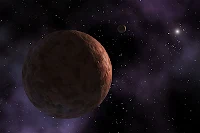Chiamatelo come volete, Nibiru, Eris, pianeta X...tutti nomi da noi attribuiti, ma eccovi le foto che difficilmente si trovano sul web dal sito della NASA.
APOD: 2006 September 18 - Eris: The Largest Known Dwarf Planet Explanation: Is Pluto the largest dwarf planet? No! Currently, the largest known dwarf planet is (136199) Eris, renamed last week from 2003 UB313. Eris is just slightly larger than Pluto, but orbits as far as twice Pluto's distance from the Sun. Eris is shown above in an image taken by a 10-meter Keck Telescope from Hawaii, USA. Like Pluto, Eris has a moon, which has been officially named by the International Astronomical Union as (136199) Eris I (Dysnomia). Dysnomia is visible above just to the right of Eris. Dwarf planets Pluto and Eris are trans-Neptunian objects that orbit in the Kuiper belt of objects past Neptune. Eris was discovered in 2003, and is likely composed of frozen water-ice and methane. Since Pluto's recent demotion by the IAU from planet to dwarf planet status, Pluto has recently also been given a new numeric designation: (134340) Pluto. Currently, the only other officially designated "dwarf planet" is (1) Ceres.
APOD: 2007 June 19 - Eris: More Massive than Pluto Explanation: Eris, a dwarf planet currently orbiting the Sun at about twice Pluto's distance, has been measured to have about 27 percent more mass than Pluto. The mass was calculated by timing the orbit of Eris' moon Dysnomia. Images taken with a ground-based Keck telescope, when combined with existing images taken by Hubble Space Telescope, show that Dysnomia has a nearly circular orbit lasting about 16 days. Cataloged as 2003 UB313 only a year ago, infrared images also showed previously that Eris is actually larger in diameter than Pluto. The plane of Eris' orbit is well out of the plane of the Solar System's planets. In the above drawing, a scientific artist has imagined Eris and Dysnomia orbiting our distant Sun. No space missions are currently planned to Eris, although the robotic New Horizons spacecraft bound for Pluto has recently passed Jupiter.
APOD: 2008 July 16 - Makemake of the Outer Solar System Explanation: Recently discovered Makemake is one of the largest objects known in the outer Solar System. Pronounced MAH-kay MAH-kay, this Kuiper belt object is only slightly smaller than Pluto, orbits the Sun only slightly further out than Pluto, and appears only slightly dimmer than Pluto. Makemake, however, has an orbit much more tilted to the ecliptic plane of the planets than Pluto. Designated 2005 FY9 soon after its discovery by a team led by Mike Brown (Caltech) in 2005, the outer Solar System orb was recently renamed Makemake for the creator of humanity in the Rapa Nui mythology of Easter Island. Additionally, Makemake has been recently classified as a dwarf planet under the new subcategory plutoid, making Makemake the third cataloged plutoid after Pluto and Eris. Makemake is known to be a world somewhat red in appearance, with spectra indicating it is likely covered with frozen methane. Since no images of Makemake's surface yet exist, an artist's illustration originally meant to depict Sedna has been boldly co-opted above to now illustrate Makemake. A hypothetical moon is visualized above nearly in the direction of our distant Sun.
APOD: 2008 September 23 - Haumea of the Outer Solar System Explanation: One of the strangest objects in the outer Solar System was classified as a dwarf planet last week and given the name Haumea. This designation makes Haumea the fifth designated dwarf planet after Pluto, Ceres, Eris, and Makemake. Haumea's smooth but oblong shape make it extremely unusual. Along one direction, Haumea is significantly longer than Pluto, while in another direction Haumea has an extent very similar to Pluto, while in the third direction is much smaller. Haumea's orbit sometimes brings it closer to the Sun than Pluto, but usually Haumea is further away. Illustrated above, an artist visualizes Haumea as a nearly featureless ellipsoid. Quite possibly, however, Haumea has interesting craters and surface features that currently remain unknown. Originally discovered in 2003 and given the temporary designation of 2003 EL61, Haumea was recently renamed by the IAU for a Hawaiian goddess. Haumea has two small moons discovered in 2005, recently renamed Hi'iaka and Namaka for daughters of the goddess.





Aucun commentaire:
Enregistrer un commentaire